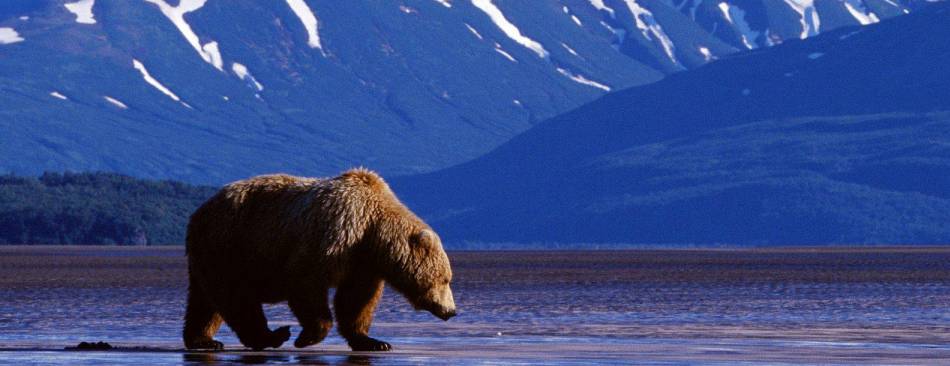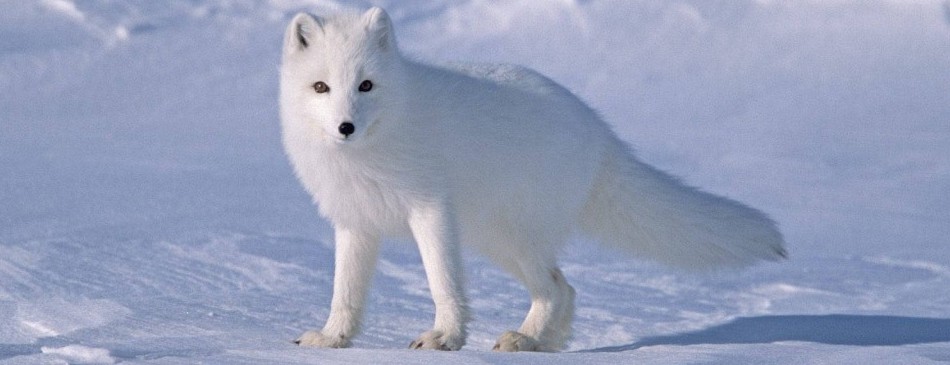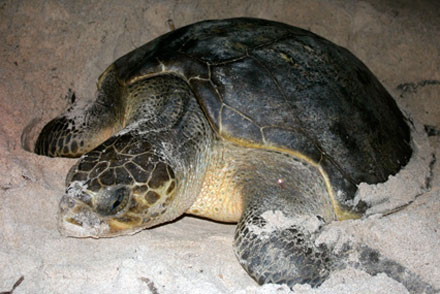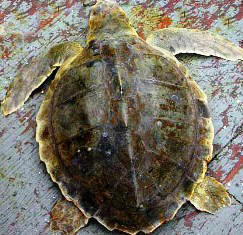Only four species of turtles, all marine turtles, have
been documented within the state’s borders. Terrestrial
and freshwater aquatic species of turtles do not occur
in Alaska. Marine turtles are occasional visitors to
Alaska’s Gulf Coast waters and are considered a natural
part of the state’s marine ecosystem.
Between 1960 and 2007 there were 19 reports of
leatherback sea turtles (Dermochelys coriacea), the
world’s largest turtle. There have been 15 reports of
Green sea turtles (Chelonia mydas). The other two are
extremely rare, there have been three reports of Olive
ridley sea turtles (Lepidochelys olivacea) and two
reports of loggerhead sea turtles (Caretta caretta).
Currently, all four species are listed as threatened or
endangered under the U.S. Endangered Species Act.
Sea turtles are large, aquatic reptiles with forelimbs specially modified for swimming. These front flippers are significantly larger than the back flippers. Their shell is composed of two pieces, the top, or carapace, and the bottom, or plastron. In most sea turtle species, the shell is made up of bony plates covered with horny shields. The olive ridley was named for the olive color of its heart-shaped shell and is one of the smallest of the sea turtles, with adults reaching 2 to 2½ feet in length and weighing 80 to 110 pounds. The species may be identified by the uniquely high and variable numbers of vertebral and costal scutes. Although some individuals have only five pairs of costals, in nearly all cases some division of costal scutes occurs, so that as many as six to nine pairs may be present. In addition, the vertebral scutes also show frequent division, as do the scales on the dorsal surface of the head. The prefrontal scales, however, typically number two pairs. Existing reports suggest that the olive ridley’s diet includes crabs, shrimp, rock lobsters, jellyfish, and tunicates. In some parts of the world, algae has been reported as its principal food.
The olive ridley is most noted for its massive nesting aggregations, known as arribadas or arribazones, with literally thousands of females nesting in large simultaneous waves over small stretches of beach. Arribadas may be precipitated by climatic events, such as a strong offshore wind, or by certain phases of the moon and tide, but there is a major element of unpredictability at all arribada sites. Although not every adult female participates in these arribadas, the vast majority do. Olive ridleys typically nest 1 to 3 times per season, producing about 100 to110 eggs on each occasion. The internesting interval is variable, but for most localities it is approximately 14 days for solitary nesters and 28 days for arribada nesters. Incubation takes about 50 to 60 days. Age at sexual maturity is not known, but if similar to its close relative the Kemp’s ridley, it would be 7 to 15 years.
Historically, adult female Olive Ridley sea turtles and their eggs were harvested for consumption. A directed harvest for sea turtles and their eggs continues in many countries today. Their skin is also used for turtle leather. The olive ridley appear to be more of an open ocean inhabitant than its congener, the Kemp’s ridley, which primarily inhabits shallow nearshore coastal waters
An increasingly large segment of society gains pleasure from observation of marine animals in their natural habitat. The opportunities for turtle watching in Alaska obviously are not as great as elsewhere, but a sighting can be very exciting, considering the rarity of such occurrences. Documenting turtle movements in Alaska waters, in addition to offering recreation, adds to the scientific knowledge of these animals in northern waters. The green sea turtle is on the federal threatened species list; the leatherback sea turtle is endangered throughout its range. Marine turtles do not represent a threat to any commercial fishery in Alaska.
Management of Olive Ridley sea turtles falls under the jurisdiction of both the National Marine Fisheries Service (NMFS) and US Fish and Wildlife Service (USFWS). NMFS is responsible for managing sea turtles at sea. When the turtles come ashore on the beaches to nest, they are the responsibility of USFWS. NMFS has implemented several fishery management measures to reduce sea turtle interactions with commercial fisheries including requiring turtle excluder devices (TEDs) on all trawl gear and the use of circle hooks in longline fisheries. The Olive Ridley sea turtle is protected under the Inter-American Convention for the Protection and Conservation of Sea Turtles and the Endangered Species Act (ESA).
|








